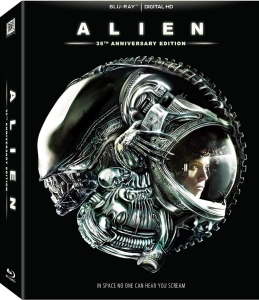“Prometheus” isn’t a masterpiece, but it’s pretty darn good, and it certainly has me on an “Alien” Universe kick this summer. So here’s the first of a series looking back at the films in the franchise so far:
Ridley Scott’s “Alien” (1979) is pretty much a perfect movie. When it comes to the methodical ratcheting up of tension, Scott plays it like a symphony. The design by H.R. Giger is equally classic, both with the alien itself and the ribbed interior of the Space Jockey’s ship. The overall design — the gritty 1970s-ness of the ship and the planet where the Nostromo lands — isn’t too shabby either (or, rather, it is shabby, but in a good way).
Scott’s orchestration of scares
Of course, when a movie has been revered for over three decades, even the things that aren’t so great about “Alien” have become lovable. The strobe lights toward the end, when Ripley is running toward the shuttle, are perhaps a bit overdone, and the “countdown to detonation” is unfortunately cliched, but today it’s charming nonetheless. Also, there are some killings where it’s hard to tell exactly what’s going on, but that’s part of the creep factor; compared to today’s films that show everything, I’ll take the former.

“Alien” (1979)
Director: Ridley Scott
Writers: Dan O’Bannon, Ronald Shusett
Stars: Sigourney Weaver, Tom Skerritt, John Hurt
A few scares, though, are the crescendo of Scott’s composition. I particularly like the final scare, where Ripley is presumably safe on the shuttle, but … that one part of the wall … it looks kind of like an alien head. And it is! And, of course, you gotta love the scene where Dallas bites the dust in the airshaft. The distant and zoomed-in camera work, plus the image of Dallas slightly crouched with a torch — that’s intense, primeval stuff.
This sequence makes great use of tracker confusion (also used brilliantly in “Aliens,” when the creatures are in the ceiling): Lambert (Veronica Cartwright, who plays “panicked” wonderfully) keeps telling Dallas that the creature should be right there — and, as he swings his torch around, suddenly it is!
“Alien” has been ripped off many times. (1997’s “Event Horizon” is one of my favorite barely concealed “Alien” remakes. It copies the notion of a distress signal that — whoops! — is actually a warning, with a delicious mistranslation: It didn’t say “Save us,” it said “Save yourselves.” And not just that, but “Save yourselves from hell.” Good stuff.)
Yet it’s hard to think of films before “Alien” that were anything like it; it’s often credited with perfecting the structure of the horror genre, where things start off innocently enough and gradually get worse until you’re seeing things you couldn’t have imagined when the movie started, such as the chestburster scene at the dining table.
Lived-in future
“Alien” did borrow from at least one movie, though: “Star Wars,” which came out two years earlier, pioneered the idea of a lived-in universe, whereas most science fiction films took it as a given that the future would look clean and sterile (Scott also used this concept — sometimes called a “dystopian future,” to contrast with “utopian” — in 1982’s “Blade Runner”).

The Nostromo, the space equivalent of a semi truck, is decidedly gritty, and it’s crew even more so. For some reason — maybe story concerns, maybe an irresistible temptation to look glossy and modern — Scott gets away from the grit in “Prometheus,” and I’ll always wonder if the prequel would’ve been better if it had a rough-around-the-edges feel, as if it had come out in 1978 rather than 2012.
The casting is spot-on, with seven character actors who really sell the space-trucker concept, starting with Tom Skerritt as business-casual captain Dallas. There’s also the banter between engineers Brett (Harry Dean Stanton) and Parker (Yaphet Kotto), who are always asking for a larger share from the Company; Ian Holm, as Ash, setting a standard for all shifty “Alien” universe robots to follow; the aforementioned Cartwright (her “Oh god!” when the chestburster emerges from Kane is so real that it must be her actual reaction to seeing the practical special effect); and, of course, Ripley.
Ripley’s just one of the guys
Sigourney Weaver is good in the role, but for many years she was lauded simply for being a woman in what was traditionally a man’s role. Ripley would show her motherly instincts in “Aliens” and her suicidal tendencies and reluctant, creepy bond with the xenomorphs in “Alien 3” and “Alien Resurrection.”
But here, she’s just one of the guys, and that set her on a path as a groundbreaking female action hero (predating Sarah Connor and Dana Scully and Buffy Summers). (Of course, “Aliens” is more of an action movie, but there are still some iconic images of Ripley wielding a flamethrower at the end of “Alien,” so I’d argue her awesomeness starts here.)
Oddities from Foster’s book
Here are a couple fun oddities from the novelization by Alan Dean Foster (novelizations are often written from earlier drafts of movies so they can hit stores before the movie is released):
- “Alien” is known for the way the xenomorph’s life cycle brilliantly mirrors the escalating tension and horror: Egg to facehugger to chestburster to full-grown alien. In the movie, one is left to assume the alien kills because it’s a killing machine, but in the book, the killings are part of the cycle of life: The alien creates a cocoon where the human victim is turned into an egg, thus re-starting the cycle; Ripley finds Dallas in this situation, begging Ripley to kill him much like Ripley’s flawed clones would in “Alien Resurrection” (and, in both cases, she pulls out the ol’ flamethrower). Fortunately, this sequence was deleted from the movie, because it allowed James Cameron to invent the Alien Queen in “Aliens.”
- The Space Jockey (the dead pilot in the horseshoe-shaped ship) that inspired so much speculation among fans, a few spinoff stories about the race (called Mala’kak in the comics and books), and ultimately, Scott and Damon Lindelof’s take on the creature in “Prometheus” (where they’re called Engineers), is nowhere to be found in the novel. Kane finds the eggs in the ship’s bowels, he gets attacked by the facehugger, and the trio returns to the Nostromo; the investigation turns up no further mysteries, other than the fact the ship is obviously alien in design. Presumably, the Space Jockey was a Giger design that Scott decided incorporate into later scripts.
What are your thoughts on what makes “Alien” a classic horror and science fiction film?
Click here for John’s reviews of all the “Aliens” and “Predator” films.

